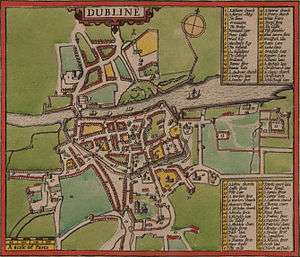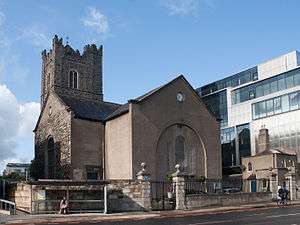St. Michan's Church, Dublin
| St. Michan's Church, Dublin | |
|---|---|
|
St Michan's Church from Church Street | |
| 53°20′51″N 6°16′32″W / 53.347455°N 6.275547°WCoordinates: 53°20′51″N 6°16′32″W / 53.347455°N 6.275547°W | |
| Location | Dublin |
| Country | Ireland |
| Denomination | Church of Ireland |
| Website | St. Michan's |
| History | |
| Founded |
1095 - Original chapel 1686 - Current structure 1825 - Renovated |
| Dedication | St. Michan (5th century)[1] |
| Architecture | |
| Architect(s) | William Robinson (1686)[2] |
| Administration | |
| Parish | Christ Church |
| Diocese | Diocese of Dublin and Glendalough |
| Province | Province of Dublin |
St. Michan's Church /ˈmɪʃən/ located in Church Street, Dublin, Ireland, is a Protestant church of the Anglican Communion. The first Christian chapel on this site dates from 1095, and operated as a Catholic church until the Reformation.[3] The current church dates from 1686, and has served Church of Ireland parishioners in Dublin for more than 300 years.
Building
Built on the site of an early Norse chapel from 1095, the current structure dates largely from a reconstruction undertaken under William Robinson in 1686,[3] but is still the only parish church on the north side of the Liffey surviving from a Viking foundation.
While the exterior of the church may be unimpressive, the interior boasts some fine woodwork, and an organ (dated 1724) on which Handel is said to have composed his Messiah.[4]
Vaults
The vaults of St. Michan's uniquely contain many mummified remains.[2] The walls in the vaults contain limestone, which has kept the air dry, creating ideal conditions for preservation.[5] Among the preserved remains are the 400-year-old body of a nun, a six-and-a-half foot man popularly believed to have been a crusader, a body with its feet and right hand severed, and the Sheares brothers—Henry and John—who took part in the 1798 rebellion. The various holders of the title Earl of Leitrim were also interred here.[6]
The church and vaults are open to tours on Saturdays, and seasonally on some weekdays. As an active place of worship however, the church is closed on Sunday to visitors.[4]
Organ
The organ, built circa 1940 by Evans and Barr of Belfast, is housed within the eighteenth-century organ case constructed by John Baptiste Cuvillie between 1723-1725.[7] The three manual pneumatic console employs modern compass and playing dimensions yet has been squeezed into the space originally occupied by much narrower keyboards. The Swell division features a slider soundboard, with separate pneumatic underaction; the Great and Choir divisions are served by sliderless ventil chests. Stopaction is pneumatic throughout.
In front of the gallery is the Organ Trophy, a carved wooden piece which depicts 17 musical instruments and was installed in 1724.[7] It is widely considered that George Frideric Handel practised in advance of the first performance of Messiah on this organ.[7][8]

Ceremonies
The Michaelmas term, and legal year, is opened with a service in St. Michan's Church every October. It is attended by members of the Irish Bar and Law Society, and is similar to the UK equivalent service at Westminster Abbey.
Gallery
 Spire
Spire Churchyard
Churchyard
References
| Wikimedia Commons has media related to St. Michan's Dublin. |
- ↑ "Brief History of St. Michan s Church Halston Street" (PDF). Capuchin Friar's website. Retrieved 26 December 2012.
- 1 2 "The Mummies of St. Michan's". Ireland for Visitors. Retrieved 5 April 2011.
- 1 2 "St. Michans - About Us - History - The origins of the Church and Parish". StMichans.com (official site). Retrieved 1 August 2014.
- 1 2 "St Michan's Church". Website of Christ Church Cathedral parishes. Retrieved 5 April 2011.
- ↑ "Waking the Dead: The Mummies of Saint Michan's Church, Dublin". Blather.net. Retrieved 5 April 2011.
- ↑ George Newenham Wright (2005). "An Historical Guide to the City of Dublin". Online book. Retrieved 2010-02-02.
- 1 2 3 "St Michan's Church organ". Website of St Michan's. Retrieved 15 May 2014.
- ↑ Horatio Townsend (1852). An account of the visit of Handel to Dublin. McGlashan. p. 96.
